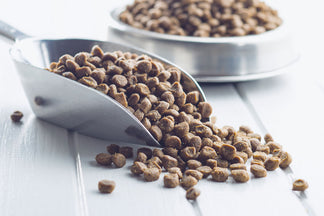Dry food is by far the most popular form of pet food sold. I saw some data on petfoodindustry.com that said that dry food makes up almost 75% of all pet food sales in the world. There are several reasons for this. First of all, dry food is convenient and doesn’t require refrigeration. Second, dry food is usually cheaper than wet (or other forms) of pet food. Many pet owners like to reduce the cost of their dry pet food even further, by purchasing the largest bag possible. These large bags usually offer the lowest unit pricing (e.g. cost per lb.) and thus, they are viewed by most consumers as being the best value. I am here to tell you that this is not necessarily true.
There is little doubt that the cost per pound of food will be less for larger bags than for smaller bags of pet food. However, the cost per lb. of quality, useful nutrition is likely higher for the larger bags in all but extreme cases. The reason for this is because for most pets, large bags of pet food will last much longer than the food remains fresh. The potency of the vitamins and nutrients will become diminished every day that the bag is opened and thus, the real value of the food will deteriorate and your pet’s body will be unable to fully utilize the food and extract its intended nutrition in the same way that it would when that bag was first opened.
Shelf Life and Expiration Dates of Pet Food
You are probably thinking I am crazy. After all, that large bag of pet food has an expiration date on it that is many months (if not years!) in the future. Thus, the food should be fine to use, right? Not so fast. The shelf life of a bag of food, as estimated by the expiration date on the bag, is calculated assuming that the package is unopened and sealed as it was when it shipped from the food manufacturer. Unfortunately, once you open the bag, the oxidation process starts immediately and the expiration date is, for all intents and purposes, meaningless.
Opened bags of pet food will immediately begin to oxidize. Oxidation causes a breakdown in nutrients and vitamin potency. The food gets ‘rusty’ and loses its nutritional punch, so to speak. Because pet foods are required to contain minimum levels of fats, these fats can turn rancid pretty quickly as well. Further damage can occur as bacteria and other toxins appear. Not only does the nutritional potency decline rapidly once the bag is opened, but you runs a (small) risk of introducing toxicity into your pet’s body by serving them ‘older’ food.
There are several veterinarians and pet nutritionists that recommend choosing smaller bags of dry food based on the fact that the food will deteriorate once the bag is opened. How long does an opened bag remain fresh? According to Steve Brown, a thought leader in canine ancestral diets, an opened bag of food will last about a week. Dr. Ava Frick, a vet and pet nutritionist suggests 3 weeks max. And storing the food in closed containers, like Tupperware or even those pet food bins with the lids, will not markedly slow the deterioration process.
Choosing the right size bag of food for your pet depends on the size of your pet and how much they are fed. A 10 lb. bag of food could last a small dog or cat 4-5 months or more, while it might only last a large dog a few weeks. In the future, I will share how to estimate the optimal bag size for a given pet and food. For now, please rethink the strategy of buying the larger bags to save money and start using smaller bags instead. This will ensure that your pet is getting fresher food that their bodies can actually utilize for their nutritional needs while also lowering the risk of unwittingly serving them rancid food that might contain harmful toxins.

 Food
Food
 Food
Food
 Food
Food
